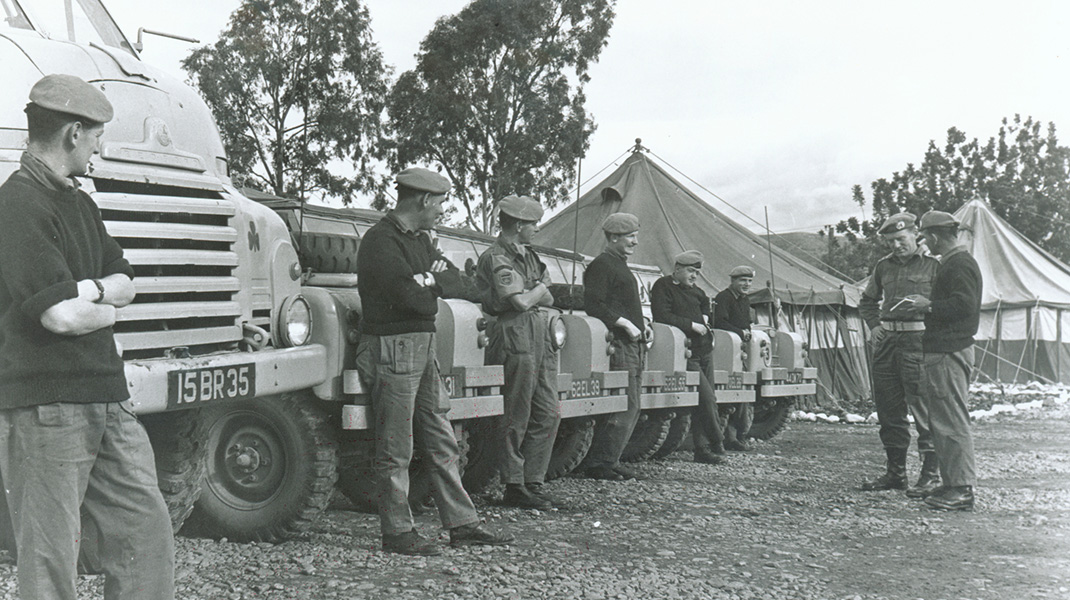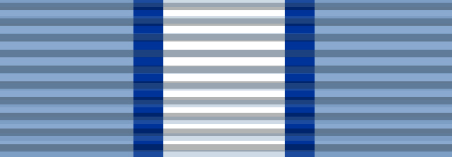The break-up of the former USSR (Soviet Union) and the re-emergence of nationalism has led to the requirement for peacekeeping forces to be deployed in parts of Central and Eastern Europe. As a result Ireland has provided military personnel, not only to the United Nations, but also to the European Community (EC), now the European Union (EU), and to the Organisation for Security and Co-Operation in Europe (OSCE).
United Nations Peacekeeping Force in Cyprus

UNFICYP – March 1964 — May 2005
The background to the Cyprus conflict is complicated and centuries old, but in simple terms it stemmed from divisions between the island’s Greek and Turkish communities. In 1960 Cyprus gained its independence from Britain. The new country’s first years were beset by problems, mainly Greek Cypriot dissatisfaction with the constitution, which they felt gave the Turkish community disproportionate representation. When attempts were made to amend the constitution the two communities began to prepare for conflict. Assistance was requested from the UN and this led to the establishment of UNFICYP. Ireland agreed to participate and in the early stages of the mission was contributing over a thousand troops who were responsible for the entire western portion of the island. The Irish Armoured Group, equipped with the new Panhard AML60s, acted as the Force Mobile Reserve.
The mission had three main aims: to prevent the recurrence of fighting; to help maintain law and order; and to contribute to the restoration of normal conditions. The deployment of UN troops in potential trouble-spots quickly managed to achieve the mission’s first aim. A coup by the Army Colonels in Greece in 1968 led to a resurgence of support in Cyprus for union with Greece. In 1973, most of the Irish contingent was transferred to the UN Emergency Force (UNEF II) in Sinai in the wake of the Yom Kippur War. In July 1974 a coup in Cyprus led to expectations of immediate union with Greece. Before this could happen Turkish forces invaded and secured the north of the island. After hostilities ended a buffer zone was formed between the two parts of the island and it was the maintenance of this ‘Green Line’ that would become UNFICYP’s main role.
Decades of political deadlock followed and the situation remains unresolved. UN Secretary General Kofi Annan sponsored the most recent attempt at reconciliation but, while it was accepted by the Turkish community, it was rejected by the Greek community. Ireland’s involvement with UNFICYP came to an end in May 2005 after 41 years of service.
| Operation Details |
| Ribbon for the Medal |
 |
| Duration: |
March 1964 — May 2005 |
| Operation type: |
UN led Peacekeeping Operations (troops) |
| Commitment: |
9655 cumulative missions |
International Security Assistance Force (Afghanistan)
ISAF – December 2001 to 2016
In 1989 Soviet forces withdrew from Afghanistan after a bloody 10-year conflict that left hundreds of thousands of Afghans dead. The communist regime they left behind fell in 1992 when mujahideen fighters took Kabul.
Rather than ending the fighting the country slipped into a vicious civil war between the various mujahideen factions.
In 1996 one group, the Taliban, comprising mainly Sunni Muslim Pashtus and foreign fighters from Pakistan, Chechnya, North Africa, and several Arab countries emerged as victors.
The Taliban introduced the strictest form of sharia (Islamic law) and allowed the establishment of international guerrilla and terrorist training camps, including Osama bin Laden’s Al Qaeda group.
In the wake of the September 11th attacks on New York in 2001 the US invaded Afghanistan with the support of the Northern Alliance, a mujahideen group opposed to the Taliban.
On December 5th, 2001 the Bonn Agreement was signed by leading Afghan political figures and representatives of the leading world powers. Resulting from this agreement an international force, ISAF, was established to secure peace and stability in Afghanistan. On December 20th, ISAF was mandated by UNSCR 1386.
The initial deployment was 5,300 troops from 30 countries, mainly concentrated on Kabul. Ireland’s contribution is seven personnel, who operate in ISAF HQ, four being employed in the Liaison and Negotiations Branch.
One of ISAF’s main aims, to assist the transitional authority in conducting free and democratic elections, was completed in 2004 with the election of President Hamid Karzai’s government.
| Operation Details |
| Ribbon for the Medal |
 |
| Duration |
December 2001 to 2016 |
| Operation type |
NATO-PfP led Peace Support Operations |
| Commitment |
226 Cumulative Missions |
UNHCR – Y
December 1992 — March 1993
Irish officers served on secondment, for 2 cumulative missions, with United Nations High Commission for Refugees — Yugoslavia (UNHCR (Y)) in the former Yugoslavia, a UN led Peacekeeping Operations (Observer) mission. Their main function was as advisers in convoy movement. Aid convoys organised by UNHCR (Y) were operating in very difficult circumstances and it was felt that they would benefit from adopting military convoy procedures, hence the need for military personnel to advise them.
United Nations Military Liaison Office in Yugoslavia United Nations Protection Force
UNPROFOR – January 1992 — January 1996
Following the ceasefire in the war between Serbia and Croatia a force of liaison officers (LOs), drawn from UNTSO and UNIKOM, was established in the former Yugoslavia to operate at the headquarters of both warring sides along the peace-line. Their function was to enhance communications between the two sides and to seek information on alleged breaches of the ceasefire. With the establishment of UNPROFOR the s undertook the task of meeting and briefing the advance recce parties. Most of the LOs operated in Croatia but there were some in Bosnia.
UNPROFORs establishment, the UNMLO group was disbanded. Most of the LOs returned to their former missions although two Irish officers remained on as part of UNPROFOR. Initially established in Croatia to ensure demilitarization of designated areas, UNPROFORs mandate was subsequently extended to cover Bosnia Herzegovina to support the delivery of humanitarian relief and to monitor ‘no fly’ zones and safe areas. The mandate was later extended to the Former Yugoslav Republic of Macedonia (FYROM) for preventive monitoring in border areas.
| Operation Details |
| Ribbon for the Medal |
 |
| Duration: |
January 1992 — January 1996 |
| Operation type: |
UN led Peacekeeping Operations (Observer) |
| Commitment: |
36 cumulative missions |
United Nations Military Observer Mission in Prevlaka
UNMOP – February 1996 — December 1999
The UNMOP mission was established by UNSCR 1038 to monitor the demilitarisation of the Prevlaka peninsula, a strategic area disputed by Croatia and the Federal Republic of Yugoslavia (FRY).
UNMOP carried out its mandate by maintaining a presence in its headquarters at Cavtat and at team sites at Herceg Novi in FRY and Gruda in Croatia.
Observers carried out vehicle, foot and standing patrols, and protested violations of the demilitarised zone to the Croatian and FRY authorities.
| Operation Details |
| Medal for the Ribbon |
 |
| Duration: |
February 1996 — December 1999 |
| Operation type: |
UN led Peacekeeping Operations (Observer) |
| Commitment: |
10 cumulative missions |
United Nations Transitional Authority in Eastern Slavonia
UNTAES – February 1996 — January 1998
The UNTAES mission was established by UNSCR 1037 to oversee the peaceful re-integration of Eastern Slavonia, Baranja and Western Sirmium into Croatia after the Balkan wars.
Its mandate included ensuring the demilitarisation of the region and providing security to personnel from the International Criminal Tribunal for the former Yugoslavia (ICTY) who were carrying out exhumations at a mass grave site in Ovcara.
UNTAES also conducted and observed successful elections in the region in April 1997.
| Operation Details |
| Ribbon for the Medal |
 |
| Duration |
February 1996 — January 1998 |
| Operation type |
UN led Peacekeeping Operations (Observer) |
| Commitment |
10 cumulative missions |
United Nations Interim Administration Mission in Kosovo
UNMIK – August 1999 – 21 Oct 2010
In June 1999, following a 78 day-long NATO campaign, the United Nations was tasked to govern Kosovo through its Interim Administration Mission in Kosovo (UNMIK), with an unprecedented sweeping mandate to provide Kosovo with a “transitional administration while establishing and overseeing the development of provisional democratic self-governing institutions to ensure conditions for a peaceful and normal life for all inhabitants in Kosovo.”
In accordance with UN Security Council Resolution 1244, UNMIK established an international presence in Kosovo.
Over the eight years since, as Kosovo’s Provisional Institutions of Self Government (PISG) were established and gained capacity to assume more responsibilities, UNMIK has moved back from an executive role to one of monitoring and support to local institutions.
| Operations Details |
| Ribbon for the Medal |
 |
| Duration |
July 1999 – October 2010 |
| Operation Type |
UN Led Peacekeeping (Observer) |
| Committment |
88 Cumulative missions |
